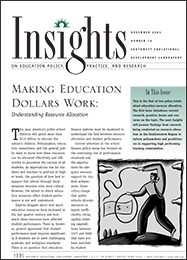At a Glance
This year, America's public school districts spend more than $310 billion to educate the nation's children. Policymakers, educators, researchers, and the general public want to know how these resources can be allocated effectively and efficiently to guarantee the success of all students. However, the extent to which education resources affect student performance is not well understood. The goal of this edition of Insights on Education Policy, Practice, and Research is to introduce state policymakers to information about current practice and research on education resource allocation and to heighten awareness of the issues and concerns regarding this topic.
Resource allocation patterns have been stable for decades.
- Fund allocations for instruction consistently constitute about 60 percent of available resources. Within the category of instruction, the percentage of resources allocated to staff salaries also has been uniform.
- Researchers have found that school districts receiving revenue increases allocate their new funds in the same broad spending categories as before the increase.
Researchers ask 'Does money make a difference?' to explore the link between resources and student performance.
- Methods designed to explain and quantify an educational production function have been used for decades, but results from such studies have not provided consistent and strong findings policymakers can use.
- New thinking suggests that resource effectiveness depends on how resources are used in instruction. What matters is what students and teachers actually do with resources, not merely whether they are present.
- Resource allocation decisions can be improved when outcomes are articulated and both the costs and benefits associated with reaching higher standards are understood and measured. Policymakers should consider the supports and challenges they may encounter in pursuing improvements to education spending.
- A thorough understanding of educational costs will help policymakers decide how to best deploy resources.
- The quality of information reporting systems will affect the ability of policymakers and other education stakeholders to see the link between resources and student performance.
- Oftentimes, states find themselves in a pattern of providing incremental resource increases for all programs without regard to their relative effectiveness in achieving state goals. Incrementalism can dilute the potential benefits of powerful strategies that require targeted infusions of resources.
- Policymakers may need to analyze whether across-the- board revenue increases are actually funding the general education program that serves the majority of students or whether they are used primarily to fund special programs.
- Organizational change processes that involve funding and services can be disruptive and unsettling to constituents and educators. Policymakers can seek ways to include the perspectives and input of all stakeholders to ease the challenges associated with change.
- Policymakers should consider the benefits of community participation in allocation decisions and develop mechanisms to open lines of communication with the public-at-large to align goals, expectations, and solutions.
Evidence suggests that education spending in U.S. districts and schools does not change easily. Decisions regarding allocation traditionally have focused on available resources rather than outputs such as student achievement. Analysis tools are available to help policymakers target spending more effectively to support student success. Developing effective resource allocation policy and practice that support increasing standards for student achievement presents challenges for policymakers, educators, and researchers.
Next Page: References & Credits

